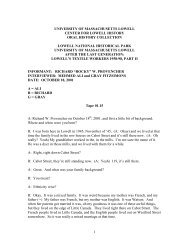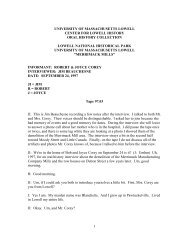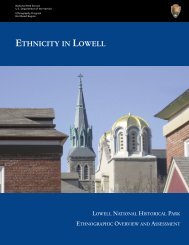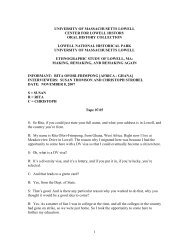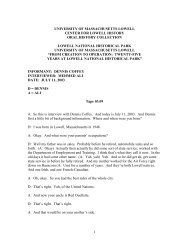LOOM AND SPINDLE OR Life Among the Early Mill Girls WITH A ...
LOOM AND SPINDLE OR Life Among the Early Mill Girls WITH A ...
LOOM AND SPINDLE OR Life Among the Early Mill Girls WITH A ...
You also want an ePaper? Increase the reach of your titles
YUMPU automatically turns print PDFs into web optimized ePapers that Google loves.
Mrs. Sarah J. Hale, in The Lady's Book, in 1842, speaking of <strong>the</strong> impossibility of<br />
considering dress a mark of distinction, says: "Many of <strong>the</strong> factory-girls wear gold<br />
watches and an imitation at least of all <strong>the</strong> ornaments which grace <strong>the</strong> daughters of our<br />
most opulent citizens."<br />
The boarding-houses were considered so attractive that strangers, by invitation, often<br />
came to look in upon <strong>the</strong>m, and see for <strong>the</strong>mselves how <strong>the</strong> mill-girls lived. Dickens, in<br />
his "American Notes," speaks with surprise of <strong>the</strong>ir home life. He says, "There is a piano<br />
in a great many of <strong>the</strong> boarding-houses, and nearly all <strong>the</strong> young ladies subscribe to<br />
circulating libraries." There was a feeling of esprit de corps among <strong>the</strong>se households; any<br />
advantage secured to one of <strong>the</strong> number was usually shared by o<strong>the</strong>rs belonging to her set<br />
or group. Books were exchanged, letters from home were read, and "pieces," intended for<br />
<strong>the</strong> Improvement Circle, were presented for friendly criticism.<br />
There was always a best room in <strong>the</strong> boardinghouse, to entertain callers in, but if any of<br />
<strong>the</strong> girls had a regular gentleman caller, a special evening was set apart each week to<br />
receive him. This room was furnished with a carpet, sometimes with a piano, as Dickens<br />
says, and with <strong>the</strong> best furniture, including oftentimes <strong>the</strong> relics of household treasures<br />
left of <strong>the</strong> old-time gentility of <strong>the</strong> house-mo<strong>the</strong>r.<br />
This mutual acquaintanceship was of great advantage. They discussed <strong>the</strong> books <strong>the</strong>y<br />
read, debated religious and social questions, compared <strong>the</strong>ir thoughts and experiences,<br />
and advised and helped one ano<strong>the</strong>r. And so <strong>the</strong>ir mental growth went on, and <strong>the</strong>y soon<br />
became educated far beyond what <strong>the</strong>ir mo<strong>the</strong>rs or <strong>the</strong>ir grandmo<strong>the</strong>rs could have been.<br />
The girls also stood by one ano<strong>the</strong>r in <strong>the</strong> mills; when one wanted to be absent half a day,<br />
two or three o<strong>the</strong>rs would tend an extra loom or frame apiece, so that <strong>the</strong> absent one<br />
might not lose her pay. At this time <strong>the</strong> mule and spinning-jenny had not been introduced;<br />
two or three looms, or spinning-frames, were as much as one girl was required to tend,<br />
more than that being considered "double work."<br />
The inmates of what may be called <strong>the</strong>se literary households were omniverous readers of<br />
books, and were also subscribers to <strong>the</strong> few magazines and literary newspapers; and it<br />
was <strong>the</strong>ir habit, after reading <strong>the</strong>ir copies, to send <strong>the</strong>m by mail or stage-coach to <strong>the</strong>ir<br />
widely scattered homes, where <strong>the</strong>y were read all over a village or a neighborhood; and<br />
thus was current literature introduced into by and lonely places.<br />
From an article in The Lowell Offering, ("Our Household," signed H. T.,) I am able to<br />
quote a sketch of one factory boarding-house interior. The author said, "In our house<br />
<strong>the</strong>re are eleven boarders, and in all thirteen members of <strong>the</strong> family. I will class <strong>the</strong>m<br />
according to <strong>the</strong>ir religious tenets as follows: Calvinist Baptist, Unitarian,<br />
Congregational, Catholic, Episcopalian, and Mormonite, one each; Universalist and<br />
Methodist, two each; Christian Baptist, three. Their reading is from <strong>the</strong> following<br />
sources: They receive regularly fifteen newspapers and periodicals; <strong>the</strong>se are, <strong>the</strong> Boston<br />
Daily Times, <strong>the</strong> Herald of Freedom, <strong>the</strong> Signs of <strong>the</strong> Times, and <strong>the</strong> Christian Herald,<br />
two copies each; <strong>the</strong> Christian Register, Vox Populi, Literary Souvenir, Boston Pilot,<br />
Young Catholic's Friend, Star of Bethlehem, and The Lotuell Offering, three copies each.



